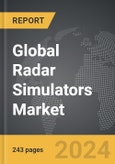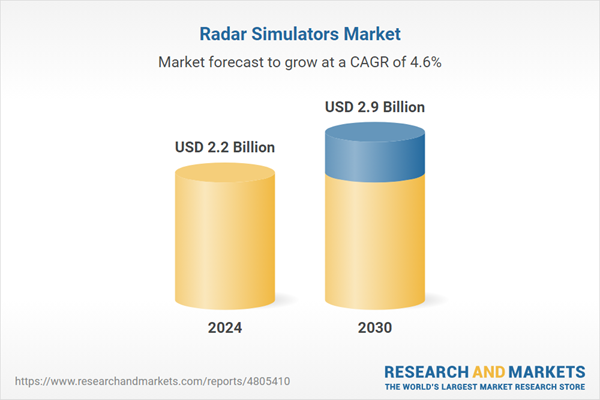The global market for Radar Simulators was valued at US$2.2 Billion in 2024 and is projected to reach US$2.9 Billion by 2030, growing at a CAGR of 4.6% from 2024 to 2030. This comprehensive report provides an in-depth analysis of market trends, drivers, and forecasts, helping you make informed business decisions. The report includes the most recent global tariff developments and how they impact the Radar Simulators market.
Segments: Product (Operation Training, System Training); Application (Military, Commercial).
Geographic Regions/Countries: World; United States; Canada; Japan; China; Europe (France; Germany; Italy; United Kingdom; and Rest of Europe); Asia-Pacific; Rest of World.
The analysts continuously track trade developments worldwide, drawing insights from leading global economists and over 200 industry and policy institutions, including think tanks, trade organizations, and national economic advisory bodies. This intelligence is integrated into forecasting models to provide timely, data-driven analysis of emerging risks and opportunities.
Global Radar Simulators Market - Key Trends and Drivers Summarized
Radar Simulators: Critical Tools for Training and System Testing
Radar simulators are sophisticated tools designed to replicate the signals and scenarios encountered by radar systems in real-world environments. These simulators are used to train military and civilian personnel in the operation of radar systems and to test and validate the performance of radar systems in a controlled, simulated environment. Radar simulators can generate a wide range of signals, including those from aircraft, ships, missiles, and other objects, allowing operators to practice detection, tracking, and identification procedures without the need for live exercises. In addition to training, radar simulators are used in the development and testing of radar systems, where they provide a cost-effective and safe way to evaluate system performance under various conditions, such as different weather, terrain, and electronic interference. By simulating complex scenarios, radar simulators help ensure that radar systems and their operators are prepared for real-world missions.How Are Technological Advancements Enhancing Radar Simulators?
Technological advancements have significantly enhanced the capabilities and realism of radar simulators, making them more effective for training and system testing. The development of digital radar simulators, which use advanced computer models and algorithms to replicate radar signals, has improved the accuracy and fidelity of simulations, enabling more realistic training scenarios. The integration of radar simulators with virtual reality (VR) and augmented reality (AR) technologies has further enhanced the immersive experience, allowing operators to interact with simulated environments in a more intuitive and engaging way. Additionally, the introduction of software-defined radar simulators has increased the flexibility of these tools, enabling them to simulate a wider range of radar systems and scenarios. Advances in computing power and graphical processing have also allowed radar simulators to handle more complex and dynamic environments, providing more detailed and varied training and testing experiences. These technological improvements are driving the adoption of radar simulators in both military and civilian sectors, where realistic and effective training and testing are essential.What Are the Key Applications and Benefits of Radar Simulators in Defense and Industry?
Radar simulators are used in a wide range of applications, offering numerous benefits that enhance training effectiveness, system testing, and operational readiness. In the defense sector, radar simulators are critical for training military personnel in the use of air defense systems, naval radar systems, and ground-based surveillance radars, where they provide realistic scenarios for detecting, tracking, and engaging targets. Radar simulators are also used in the development and testing of new radar systems, where they enable engineers to evaluate system performance under different conditions and refine system design before deployment. In the aerospace industry, radar simulators are used to train pilots and air traffic controllers in radar-based navigation and collision avoidance procedures, ensuring safety and efficiency in air operations. Additionally, radar simulators are used in the automotive industry to test radar sensors used in autonomous vehicles and advanced driver assistance systems (ADAS), where they provide a controlled environment for evaluating sensor performance in various driving scenarios. The primary benefits of radar simulators include their ability to replicate complex radar scenarios, provide safe and cost-effective training and testing, and support the development of advanced radar systems, making them essential tools in defense and industry.What Factors Are Driving the Growth in the Radar Simulators Market?
The growth in the Radar Simulators market is driven by several factors. The increasing demand for realistic and effective training solutions in the defense sector is a significant driver, as radar simulators are essential for preparing military personnel for complex and high-risk operations. Technological advancements in simulation technology, including the integration of VR and AR, are also propelling market growth by enhancing the realism and effectiveness of radar simulators. The rising need for cost-effective and safe testing solutions in the development of radar systems is further boosting demand for radar simulators, as they provide a controlled environment for evaluating system performance. Additionally, the growth of the aerospace and automotive industries is contributing to market growth, as these sectors require advanced radar simulators for training and testing purposes. The expansion of radar technology into new areas, such as autonomous vehicles and smart cities, is also supporting the adoption of radar simulators in various applications. These factors, combined with continuous innovation in simulation technology, are driving the sustained growth of the Radar Simulators market.Report Scope
The report analyzes the Radar Simulators market, presented in terms of units. The analysis covers the key segments and geographic regions outlined below.Segments: Product (Operation Training, System Training); Application (Military, Commercial).
Geographic Regions/Countries: World; United States; Canada; Japan; China; Europe (France; Germany; Italy; United Kingdom; and Rest of Europe); Asia-Pacific; Rest of World.
Key Insights:
- Market Growth: Understand the significant growth trajectory of the Operation Training segment, which is expected to reach US$1.9 Billion by 2030 with a CAGR of a 4.5%. The System Training segment is also set to grow at 4.8% CAGR over the analysis period.
- Regional Analysis: Gain insights into the U.S. market, valued at $589.1 Million in 2024, and China, forecasted to grow at an impressive 4.2% CAGR to reach $448.0 Million by 2030. Discover growth trends in other key regions, including Japan, Canada, Germany, and the Asia-Pacific.
Why You Should Buy This Report:
- Detailed Market Analysis: Access a thorough analysis of the Global Radar Simulators Market, covering all major geographic regions and market segments.
- Competitive Insights: Get an overview of the competitive landscape, including the market presence of major players across different geographies.
- Future Trends and Drivers: Understand the key trends and drivers shaping the future of the Global Radar Simulators Market.
- Actionable Insights: Benefit from actionable insights that can help you identify new revenue opportunities and make strategic business decisions.
Key Questions Answered:
- How is the Global Radar Simulators Market expected to evolve by 2030?
- What are the main drivers and restraints affecting the market?
- Which market segments will grow the most over the forecast period?
- How will market shares for different regions and segments change by 2030?
- Who are the leading players in the market, and what are their prospects?
Report Features:
- Comprehensive Market Data: Independent analysis of annual sales and market forecasts in US$ Million from 2024 to 2030.
- In-Depth Regional Analysis: Detailed insights into key markets, including the U.S., China, Japan, Canada, Europe, Asia-Pacific, Latin America, Middle East, and Africa.
- Company Profiles: Coverage of players such as Adacel Technologies Ltd., ARI Simulation, AWT Global LLC, Buffalo Computer Graphics, Inc., Collins Aerospace and more.
- Complimentary Updates: Receive free report updates for one year to keep you informed of the latest market developments.
Some of the 43 companies featured in this Radar Simulators market report include:
- Adacel Technologies Ltd.
- ARI Simulation
- AWT Global LLC
- Buffalo Computer Graphics, Inc.
- Collins Aerospace
- D-TA Systems Inc.
- HENSOLDT AG
- Mercury Systems, Inc.
- MicroKim
- Unistring Tech Solutions Pvt. Ltd
Tariff Impact Analysis: Key Insights for 2025
Global tariff negotiations across 180+ countries are reshaping supply chains, costs, and competitiveness. This report reflects the latest developments as of April 2025 and incorporates forward-looking insights into the market outlook.The analysts continuously track trade developments worldwide, drawing insights from leading global economists and over 200 industry and policy institutions, including think tanks, trade organizations, and national economic advisory bodies. This intelligence is integrated into forecasting models to provide timely, data-driven analysis of emerging risks and opportunities.
What’s Included in This Edition:
- Tariff-adjusted market forecasts by region and segment
- Analysis of cost and supply chain implications by sourcing and trade exposure
- Strategic insights into geographic shifts
Buyers receive a free July 2025 update with:
- Finalized tariff impacts and new trade agreement effects
- Updated projections reflecting global sourcing and cost shifts
- Expanded country-specific coverage across the industry
Table of Contents
I. METHODOLOGYII. EXECUTIVE SUMMARY2. FOCUS ON SELECT PLAYERSIII. MARKET ANALYSISIV. COMPETITION
1. MARKET OVERVIEW
3. MARKET TRENDS & DRIVERS
4. GLOBAL MARKET PERSPECTIVE
UNITED STATES
CANADA
JAPAN
CHINA
EUROPE
FRANCE
GERMANY
ITALY
UNITED KINGDOM
REST OF EUROPE
ASIA-PACIFIC
REST OF WORLD
Companies Mentioned (Partial List)
A selection of companies mentioned in this report includes, but is not limited to:
- Adacel Technologies Ltd.
- ARI Simulation
- AWT Global LLC
- Buffalo Computer Graphics, Inc.
- Collins Aerospace
- D-TA Systems Inc.
- HENSOLDT AG
- Mercury Systems, Inc.
- MicroKim
- Unistring Tech Solutions Pvt. Ltd
Table Information
| Report Attribute | Details |
|---|---|
| No. of Pages | 243 |
| Published | April 2025 |
| Forecast Period | 2024 - 2030 |
| Estimated Market Value ( USD | $ 2.2 Billion |
| Forecasted Market Value ( USD | $ 2.9 Billion |
| Compound Annual Growth Rate | 4.6% |
| Regions Covered | Global |









